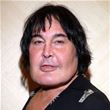Cherubism is a medical condition where bone is replaced with fibrous tissue resulting in bone growth. This can result in enlarged bones such as the jaw. Cherubism shows that the key to inducing neo-height growth may be osteoclastic activity which is what permits the growth.
<-Robert Z’dar had cherubism.
This enlargement seems to occur without growth plates and seems to be a result of osteoclastic, fibroblastic, and cystic activities.
Even more interesting cherubism can occur in an adult.
Recurrent cherubism in an adult patient.<-I can’t get this study right now I’ll have to get it later.
Here’s an image of the osteoclastic cells in cherubism:
from Cherubism: best clinical practice. According to this study the lesions are fibro-osseous and occur until puberty.
Late reactivation of cherubism in an adult further to local inflammation
“Cherubism is a rare pediatric disease affecting the jaw. It appears among children between 2 and 5 years old. Maximum growth is observed at 7–8 years old, then lesions remain unchanged or increase slowly until puberty. Only 2 cases of later growth have been reported{but if there is later growth that can providence that adult height growth is possible}. We describe a case of cherubism reactivation in a 46-year-old woman. Appearance of a new lesion occurs in a context of local inflammation due to repeated friction of the dental prosthesis on the mandible. No article in the literature describes a similar case. This case shows the determining role of inflammation (local or general) in the pathophysiology of cherubism.”
“Cherubism is a rare pediatric disease. It is a genetic autosomic dominant disease, due to mutations of the SH3BP2 gene on chromosome 4p16.3. Half of the cases are linked to family history; the other half seems linked to de novo mutations.”
“In some cases, severe bone enlargement”
“These lesions regress or stabilize spontaneously after puberty. At the 40th year of life, lesions are frequently not detectable”
“We describe a case of mandibular expansion reactivation after skeletal maturity was reached. “<-so this is basically adult longitudinal bone growth as the mandibular was expanded.
“Lesion consisting of oval mononuclear cells without atypia and osteoclast-like giant cells, punctuated by hematic suffusions”
“At 46 years old, patient still has cherubism lesions on the mandibular symphysis and ramus. These lesions remained quiescent and did not disappear after skeletal maturity was reached.”
“Mutation of SH3BP2 gene leads to autoimmune inflammation response with increase and activation of macrophages and osteoclasts responsible for bone resorption and fibrous tissue implantation.”<-so osteoclasts are what allows for the new growth.


